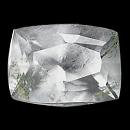|
Click on a letter above to view the list of gems. |
|
|
|
|
|
|
|
|
Gaylussite |
|
| | |
| Discovered in 1826; IMA status: Valid (pre-IMA; Grandfathered). | ||
|
| ||
|
Chemistry |
|
|
| |
|
Na2Ca(CO3)2·5(H2O) | |
|
|
Hydrated Sodium Calcium Carbonate |
|
Molecular Weight: |
296.15 gm |
|
Composition: |
Sodium |
15.53 % |
Na |
20.93 % |
Na2O |
|
|
Calcium |
13.53 % |
Ca |
18.94 % |
CaO |
|
|
Hydrogen |
3.40 % |
H |
30.42 % |
H2O |
|
|
Carbon |
8.11 % |
C |
29.72 % |
CO2 |
|
|
Oxygen |
59.43 % |
O |
|
|
|
|
|
100.00 % |
|
100.00 % |
= TOTAL OXIDE |
|
|
|
||||
|
Classification |
|
|
| |
|
Carbonates | |
|
5/D.02-60 | |
|
|
5 : CARBONATES (NITRATES) |
|
Related to: |
Thermonatrite - Chalconatronite Series |
|
Synonyms: |
Gaylussacite, Gay-Lussite, Natrocalcite |
|
|
|
|
Crystal Data |
|
|
|
|
|
Includes intricately faceted prismatic to tabular crystals, but also massive and encrusting. Crystals frequently elongated [100]; also flattened, wedge-shaped, with dominant [110], and [011]. Surfaces commonly rough, with [011] striated [111]. |
|
|
None |
|
|
|
|
|
Physical Properties |
|
|
|
|
|
[110] Perfect, [001] Imperfect |
|
|
Conchoidal |
|
|
Very Brittle |
|
|
2.5 - 3.0 |
|
|
1.93 - 1.99 (g/cm3) |
|
|
None |
|
|
Not Radioactive |
|
|
Other: |
Dehydrates slowly with efflorescence in dry air; slowly decomposes in water leaving CaCO3 as Calcite or Aragonite. Soluble in acids with effervescence. Slightly soluble in water. Alters readily to calcite. |
|
|
|
|
Optical Properties |
|
|
|
|
|
Colourless, Yellowish, Greyish, White; Colourless in transmitted light. |
|
|
Transparent to Translucent |
|
|
Vitreous |
|
|
1.444 - 1.523 Biaxial ( - ) |
|
|
0.0790 |
|
|
Strong; r < v |
|
|
None |
|
|
|
|
|
Occurances |
|
|
|
|
|
Geological Setting: |
Typically in evaporites or shales from alkali lakes; rarely in veinlets cutting alkalic igneous rocks. Lacustrine clay sediments in an alkali lake. |
|
Common Associations: |
Shortite, Northupite, Pirssonite, Trona (Green River Formation, Wyoming, USA); Aegirine, Ferrian “Biotite”, Pectolite, Potassian Feldspar, Shortite, Thermonatrite, Villiaumite (Khibiny massif, Russia). |
|
Type Locality: |
Lagunilla, Mérida, Venezuela |
|
Year Discovered: |
1826 |
|
View mineral photos: | |
|
|
|
|
More Information |
|
|
|
|
|
| |
|
|
|
|
Notable occurrences include Searles Lake,
San Berardino County;
Deep Spring and Owens Lake, Inyo County; Borax Lake, Lake County and China Lake, Kern County, California, USA;
Gobi Desert, Mongolia and Lagunillas, Merida, Venezuela. |
|
|
We
have not photographed our Gaylussite gems. Please
check back soon. |
